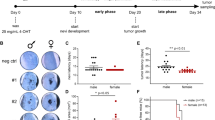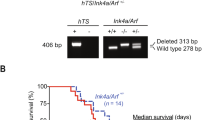Abstract
CDKN2A (INK4a/ARF) is frequently disrupted in various types of human cancer, and germline mutations of this locus can confer susceptibility to melanoma and other tumours1. However, because CDKN2A encodes two distinct cell cycle inhibitory proteins, p16INK4a and p14ARF (p19Arf in mice)2, the mechanism of tumour suppression by CDKN2A has remained controversial. Genetic disruption of Cdkn2a(p19Arf) (hereafter Arf) alone predisposes mice to tumorigenesis3, demonstrating that Arf is a tumour-suppressor gene in mice. We mutated mice specifically in Cdkn2a(p16Ink4a) (hereafter Ink4a). Here we demonstrate that these mice, designated Ink4a*/*, do not show a significant predisposition to spontaneous tumour formation within 17 months. Embryo fibroblasts derived from them proliferate normally, are mortal, and are not transformed by oncogenic HRAS. The very mild phenotype of the Ink4a*/* mice implies that the very strong phenotypes of the original Ink4a/ArfΔ2,3 mice were primarily or solely due to loss of Arf. However, Ink4a*/Δ2,3 mice that are deficient for Ink4a and heterozygous for Arf spontaneously develop a wide spectrum of tumours, including melanoma. Treatment of these mice with the carcinogen 7,12-dimethylbenzanthracene (DMBA) results in an increased incidence of melanoma, with frequent metastases. Our results show that, in the mouse, Ink4a is a tumour-suppressor gene that, when lost, can recapitulate the tumour predisposition seen in humans.
This is a preview of subscription content, access via your institution
Access options
Subscribe to this journal
Receive 51 print issues and online access
$199.00 per year
only $3.90 per issue
Buy this article
- Purchase on Springer Link
- Instant access to full article PDF
Prices may be subject to local taxes which are calculated during checkout




Similar content being viewed by others
References
Ruas, M. & Peters, G. The p16INK4a/CDKN2A tumor suppressor and its relatives. Biochim. Biophys. Acta 1378, F115–F177 (1998).
Sherr, C. J. Tumor surveillance via the ARF–p53 pathway. Genes Dev. 12, 2984–2991 (1998).
Kamijo, T. et al. Tumor suppression at the mouse INK4a locus mediated by the alternative reading frame product p19ARF. Cell 91, 649–659 (1997).
Sherr, C. J. & Roberts, J. M. CDK inhibitors: positive and negative regulators of G1-phase progression. Genes Dev. 13, 1501–1512 (1999).
Sharpless, N. E. & DePinho, R. A. The INK4A/ARF locus and its two gene products. Curr. Opin. Genet. Dev. 9, 22–30 (1999).
Arap, W., Knudsen, E. S., Wang, J. Y., Cavenee, W. K. & Huang, H. J. Point mutations can inactivate in vitro and in vivo activities of p16(INK4a)/CDKN2A in human glioma. Oncogene 14, 603–609 (1997).
Harvey, M. et al. growth characteristics of embryo fibroblasts isolated from p53-deficient mice. Oncogene 8, 2457–2467 (1993).
Serrano, M., Lin, A. W., McCurrach, M. E., Beach, D. & Lowe, S. W. Oncogenic ras provokes premature cell senescence associated with accumulation of p53 and p16INK4a. Cell 88, 593–602 (1997).
Carnero, A., Hudson, J. D., Price, C. M. & Beach, D. H. p16INK4A and p19ARF act in overlapping pathways in cellular immortalization. Nature Cell Biol. 2, 148–155 (2000).
Sage, J. et al. Targeted disruption of the three Rb-related genes leads to loss of G(1) control and immortalization. Genes Dev. 14, 3037–3050 (2000).
Dannenberg, J. H., van Rossum, A., Schuijff, L. & te Riele, H. Ablation of the retinoblastoma gene family deregulates G(1) control causing immortalization and increased cell turnover under growth-restricting conditions. Genes Dev. 14, 3051–3064 (2000).
Wright, W. E. & Shay, J. W. Cellular senescence as a tumor-protection mechanism: the essential role of counting. Curr. Opin. Genet. Dev. 11, 98–103 (2001).
Kiyono, T. et al. Both Rb/p16INK4a inactivation and telomerase activity are required to immortalize human epithelial cells. Nature 396, 84–88 (1998).
Zhu, J., Woods, D., McMahon, M. & Bishop, J. M. Senescence of human fibroblasts induced by oncogenic Raf. Genes Dev. 12, 2997–3007 (1998).
Peeper, D. S., Dannenberg, J. H., Douma, S., te Riele, H. & Bernards, R. Escape from premature senescence is not sufficient for oncogenic transformation by Ras. Nature Cell Biol. 3, 198–203 (2001).
Todaro, G. J. & Green, H. Quantitative studies of the growth of mouse embryo cells in culture and their development into established lines. J. Cell Biol. 17, 299–313 (1963).
Schmitt, C. A., McCurrach, M. E., de Stanchina, E., Wallace-Brodeur, R. R. & Lowe, S. W. INK4a/ARF mutations accelerate lymphomagenesis and promote chemoresistance by disabling p53. Genes Dev. 13, 2670–2677 (1999).
Serrano, M. et al. Role of the INK4a locus in tumor suppression and cell mortality. Cell 85, 27–37 (1996).
Kamijo, T., Bodner, S., van de Kamp, E., Randle, D. H. & Sherr, C. J. Tumor spectrum in ARF-deficient mice. Cancer Res. 59, 2217–2222 (1999).
Eischen, C. M., Weber, J. D., Roussel, M. F., Sherr, C. J. & Cleveland, J. L. Disruption of the ARF–Mdm2–p53 tumor suppressor pathway in Myc-induced lymphomagenesis. Genes Dev. 13, 2658–2669 (1999).
Jacobs, J. J. et al. Bmi-1 collaborates with c-Myc in tumorigenesis by inhibiting c-Myc-induced apoptosis via INK4a/ARF. Genes Dev. 13, 2678–2690 (1999).
Rizos, H., Becker, T. M., Holland, E. A., Kefford, R. F. & Mann, G. J. Differential expression of p16INK4a and p16β transcripts in B-lymphoblastoid cells from members of hereditary melanoma families without CDKN2A exon mutations. Oncogene 15, 515–523 (1997).
Randerson-Moor, J. A. et al. A germline deletion of p14(ARF) but not CDKN2A in a melanoma-neural system tumour syndrome family. Hum. Mol. Genet. 10, 55–62 (2001).
Burri, N. et al. Methylation silencing and mutations of the p14ARF and p16INK4a genes in colon cancer. Lab. Invest. 81, 217–229 (2001).
Robanus-Maandag, E. et al. p107 is a suppressor of retinoblastoma development in pRb-deficient mice. Genes Dev. 12, 1599–1609 (1998).
Schwenk, F., Baron, U. & Rajewsky, K. A cre-transgenic mouse strain for the ubiquitous deletion of loxP-flanked gene segments including deletion in germ cells. Nucleic Acids Res. 23, 5080–5081 (1995).
Morgenstern, J. P. & Land, H. Advanced mammalian gene transfer: high titre retroviral vectors with multiple drug selection markers and a complementary helper-free packaging cell line. Nucleic Acids Res. 18, 3587–3596 (1990).
Acknowledgements
We thank D. Peeper and M. van Lohuizen for advice and retroviral vectors, M. van der Valk for histological analysis, K. Rajewsky for the Deleter Cre mice, C. Sherr for Arf-/- MEFs, G. Nolan for ΦNX-E retroviral producer cells, and J. Vink and K. van Veen for technical assistance, and the Netherlands Cancer Institute animal facility for providing animal care. Part of this work was supported by the Dutch Cancer Society.
Author information
Authors and Affiliations
Corresponding author
Supplementary information
Rights and permissions
About this article
Cite this article
Krimpenfort, P., Quon, K., Mooi, W. et al. Loss of p16Ink4a confers susceptibility to metastatic melanoma in mice. Nature 413, 83–86 (2001). https://doi.org/10.1038/35092584
Received:
Accepted:
Issue Date:
DOI: https://doi.org/10.1038/35092584
This article is cited by
-
Cellular senescence and neurodegeneration
Human Genetics (2023)
-
Non-canonical functions of SNAIL drive context-specific cancer progression
Nature Communications (2023)
-
A natural WNT signaling variant potently synergizes with Cdkn2ab loss in skin carcinogenesis
Nature Communications (2019)
-
Sexually dimorphic leanness and hypermobility in p16Ink4a/CDKN2A-deficient mice coincides with phenotypic changes in the cerebellum
Scientific Reports (2019)
-
Targeting senescence to delay progression of multiple sclerosis
Journal of Molecular Medicine (2018)
Comments
By submitting a comment you agree to abide by our Terms and Community Guidelines. If you find something abusive or that does not comply with our terms or guidelines please flag it as inappropriate.



